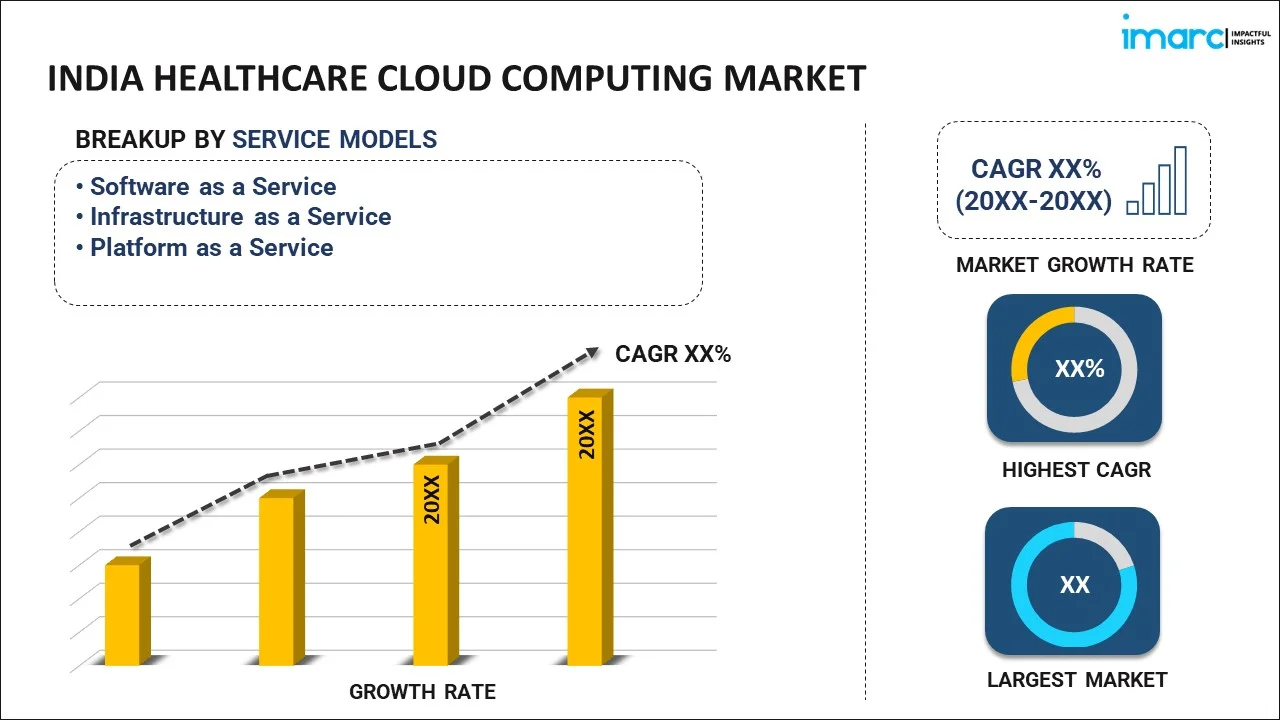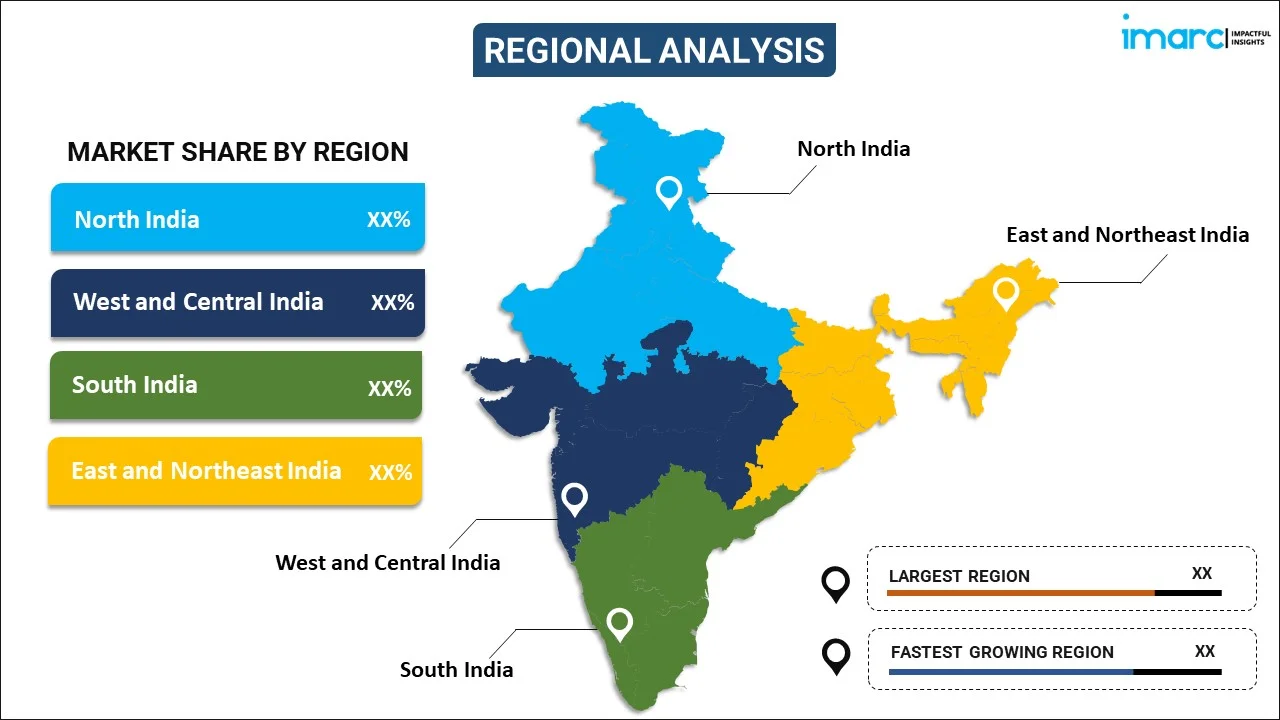
India Healthcare Cloud Computing Market Report by Service Model (Software as a Service, Infrastructure as a Service, Platform as a Service), Cloud Deployment Model (Private Cloud, Public Cloud, Hybrid Cloud), Application (Clinical Information System, Non-Clinical Information System), End User (Healthcare Providers, Healthcare Payers), and Region 2025-2033
Market Overview:
India healthcare cloud computing market size reached USD 1,667.0 Million in 2024. Looking forward, IMARC Group expects the market to reach USD 4,179.2 Million by 2033, exhibiting a growth rate (CAGR) of 10.8% during 2025-2033. The launch of government initiatives supporting digitization in healthcare, coupled with the growing awareness among individuals towards the advantages offered by cloud solutions, is among the key factors driving the market growth.
|
Report Attribute
|
Key Statistics
|
|---|---|
|
Base Year
|
2024
|
|
Forecast Years
|
2025-2033
|
|
Historical Years
|
2019-2024
|
| Market Size in 2024 | USD 1,667.0 Millio |
| Market Forecast in 2033 | USD 4,179.2 Million |
| Market Growth Rate 2025-2033 | 10.8% |
Healthcare cloud computing utilizes distant servers and networks for the storage, management, processing, and sharing of healthcare data and applications through the Internet. This approach empowers healthcare organizations with on-demand access to resources, fostering efficiency, collaboration, and scalability. Authorized users can securely access patient data and applications from diverse locations, facilitating remote work and patient care. The reliance on remote servers eliminates the necessity of investing in and managing on-site hardware, leading to reduced capital expenditures and predictable operational costs. Additionally, healthcare cloud computing facilitates smooth integration and data sharing across various healthcare systems, contributing to enhanced care coordination and information exchange.
India Healthcare Cloud Computing Market Trends:
The healthcare cloud computing market in India is experiencing significant growth, fueled by technological advancements, increased digitization in the healthcare sector, and the growing recognition of the benefits offered by cloud solutions. One of the key drivers of this market growth is the ability of healthcare cloud computing to provide on-demand access to resources, promoting efficiency, collaboration, and scalability for healthcare organizations. Moreover, authorized users, including healthcare professionals, can securely access patient data and applications from various locations, facilitating remote work and improving the delivery of patient care. Besides this, a notable advantage of healthcare cloud computing is the reduction in the need for on-site hardware investments and maintenance. Predictable operational costs further contribute to the appeal of cloud solutions in the healthcare sector. Furthermore, healthcare cloud computing enables seamless integration and data sharing among different healthcare systems. This interoperability enhances care coordination and information exchange, leading to improved patient outcomes and a more connected healthcare ecosystem. Besides this, as India continues to witness a digital transformation in healthcare, with increased adoption of electronic health records (EHRs) and telemedicine, the healthcare cloud computing market is poised for sustained growth over the forecasted period.
India Healthcare Cloud Computing Market Segmentation:
IMARC Group provides an analysis of the key trends in each segment of the market, along with forecasts at the country level for 2025-2033. Our report has categorized the market based on service model, cloud deployment model, application, and end user.
Service Model Insights:

- Software as a Service
- Infrastructure as a Service
- Platform as a Service
The report has provided a detailed breakup and analysis of the market based on the service model. This includes software as a service, infrastructure as a service, and platform as a service.
Cloud Deployment Model Insights:
- Private Cloud
- Public Cloud
- Hybrid Cloud
A detailed breakup and analysis of the market based on the cloud deployment model have also been provided in the report. This includes private cloud, public cloud, and hybrid cloud.
Application Insights:
- Clinical Information System
- Computerized Physician Order Entry
- Electronic Medical Records
- Radiology Information System
- Pharmacy Information System
- Others
- Non-clinical Information System
- Automatic Patient Billing
- Revenue Cycle Management
- Claims Management
- Others
The report has provided a detailed breakup and analysis of the market based on the application. This includes clinical information system (computerized physician order entry, electronic medical records, radiology information system, pharmacy information system, and others) and non-clinical information system (automatic patient billing, revenue cycle management, claims management, and others).
End User Insights:
- Healthcare Providers
- Healthcare Payers
A detailed breakup and analysis of the market based on the end user have also been provided in the report. This includes healthcare providers and healthcare payers.
Regional Insights:

- North India
- West and Central India
- South India
- East and Northeast India
The report has also provided a comprehensive analysis of all the major regional markets, which include North India, West and Central India, South India, and East and Northeast India.
Competitive Landscape:
The market research report has also provided a comprehensive analysis of the competitive landscape. Competitive analysis such as market structure, key player positioning, top winning strategies, competitive dashboard, and company evaluation quadrant has been covered in the report. Also, detailed profiles of all major companies have been provided.
India Healthcare Cloud Computing Market Report Coverage:
| Report Features | Details |
|---|---|
| Base Year of the Analysis | 2024 |
| Historical Period | 2019-2024 |
| Forecast Period | 2025-2033 |
| Units | Million USD |
| Scope of the Report | Exploration of Historical Trends and Market Outlook, Industry Catalysts and Challenges, Segment-Wise Historical and Future Market Assessment:
|
| Service Models Covered | Software as a Service, Infrastructure as a Service, Platform as a Service |
| Cloud Deployment Models Covered | Private Cloud, Public Cloud, Hybrid Cloud |
| Applications Covered |
|
| End Users Covered | Healthcare Providers, Healthcare Payers |
| Regions Covered | North India, West and Central India, South India, East and Northeast India |
| Customization Scope | 10% Free Customization |
| Post-Sale Analyst Support | 10-12 Weeks |
| Delivery Format | PDF and Excel through Email (We can also provide the editable version of the report in PPT/Word format on special request) |
Key Questions Answered in This Report:
- How has the India healthcare cloud computing market performed so far and how will it perform in the coming years?
- What has been the impact of COVID-19 on the India healthcare cloud computing market?
- What is the breakup of the India healthcare cloud computing market on the basis of service model?
- What is the breakup of the India healthcare cloud computing market on the basis of cloud deployment model?
- What is the breakup of the India healthcare cloud computing market on the basis of application?
- What is the breakup of the India healthcare cloud computing market on the basis of end user?
- What are the various stages in the value chain of the India healthcare cloud computing market?
- What are the key driving factors and challenges in the India healthcare cloud computing?
- What is the structure of the India healthcare cloud computing market and who are the key players?
- What is the degree of competition in the India healthcare cloud computing market?
Key Benefits for Stakeholders:
- IMARC’s industry report offers a comprehensive quantitative analysis of various market segments, historical and current market trends, market forecasts, and dynamics of the India healthcare cloud computing market from 2019-2033.
- The research report provides the latest information on the market drivers, challenges, and opportunities in the India healthcare cloud computing market.
- Porter's five forces analysis assist stakeholders in assessing the impact of new entrants, competitive rivalry, supplier power, buyer power, and the threat of substitution. It helps stakeholders to analyze the level of competition within the India healthcare cloud computing industry and its attractiveness.
- Competitive landscape allows stakeholders to understand their competitive environment and provides an insight into the current positions of key players in the market.
Need more help?
- Speak to our experienced analysts for insights on the current market scenarios.
- Include additional segments and countries to customize the report as per your requirement.
- Gain an unparalleled competitive advantage in your domain by understanding how to utilize the report and positively impacting your operations and revenue.
- For further assistance, please connect with our analysts.
 Inquire Before Buying
Inquire Before Buying
 Speak to an Analyst
Speak to an Analyst
 Request Brochure
Request Brochure
 Request Customization
Request Customization




.webp)




.webp)












